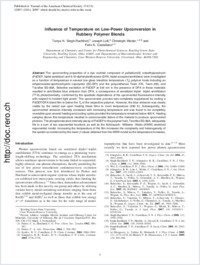Influence of temperature on low-power upconversion in rubbery polymer blends
- Singh-Rachford, Tanya N. Department of Chemistry and Center for Photochemical Sciences, Bowling Green State University, Ohio, USA
- Lott, Joseph Departments of Macromolecular Science and Engineering and Chemistry, Case Western Reserve University, Cleveland, Ohio, USA
- Weder, Christoph Departments of Macromolecular Science and Engineering and Chemistry, Case Western Reserve University, Cleveland, Ohio, USA - Adolphe Merkle Institute and Fribourg Center for Materials, University of Fribourg, Switzerland
- Castellano, Felix N. Department of Chemistry and Center for Photochemical Sciences, Bowling Green State University, Ohio, USA
-
03.08.2009
Published in:
- Journal of the American Chemical Society. - 2009, vol. 131, no. 33, p. 12007–12014
English
The upconverting properties of a dye cocktail composed of palladium(II) octaethylporphyrin (PdOEP, triplet sensitizer) and 9,10-diphenylanthracene (DPA, triplet acceptor/annihilator) were investigated as a function of temperature in several low glass transition temperature (Tg) polymer hosts including an ethyleneoxide-epichlorohydrin copolymer (EO-EPI) and the polyurethanes Texin 270, Texin 285, and Tecoflex EG-80A. Selective excitation of PdOEP at 544 nm in the presence of DPA in these materials resulted in anti-Stokes blue emission from DPA, a consequence of sensitized triplet−triplet annihilation (TTA) photochemistry, confirmed by the quadratic dependence of the upconverted fluorescence intensity with respect to incident light power. The upconversion process was completely suppressed by cooling a PdOEP/DPA blend film to below the Tg of the respective polymer. However, the blue emission was clearly visible by the naked eye upon heating these films to room temperature (290 K). Subsequently, the upconverted emission intensity increased with increasing temperature and was found to be completely reversible upon several heating and cooling cycles provided the temperature remained below 400 K. Heating samples above this temperature resulted in unrecoverable failure of the material to produce upconverted photons. The phosphorescence intensity decay of PdOEP in the polymer host, Tecoflex EG-80A, adequately fits to a sum of two exponential functions as well as the Kohlrausch−Williams−Watts (KWW) stretched exponential model. Increasing the temperature of the film increases the complexity and heterogeneity of the system as evidenced by the lower β values obtained from the KWW model as the temperature increases.
- Faculty
- Faculté des sciences et de médecine
- Department
- AMI - Chimie des polymères et matériaux
- Language
-
- English
- Classification
- Physics
- License
-
License undefined
- Identifiers
-
- RERO DOC 13252
- DOI 10.1021/ja904696n
- Persistent URL
- https://folia.unifr.ch/unifr/documents/301371
Other files
Statistics
Document views: 109
File downloads:
- pdf: 308
- Supplementary material: 132

